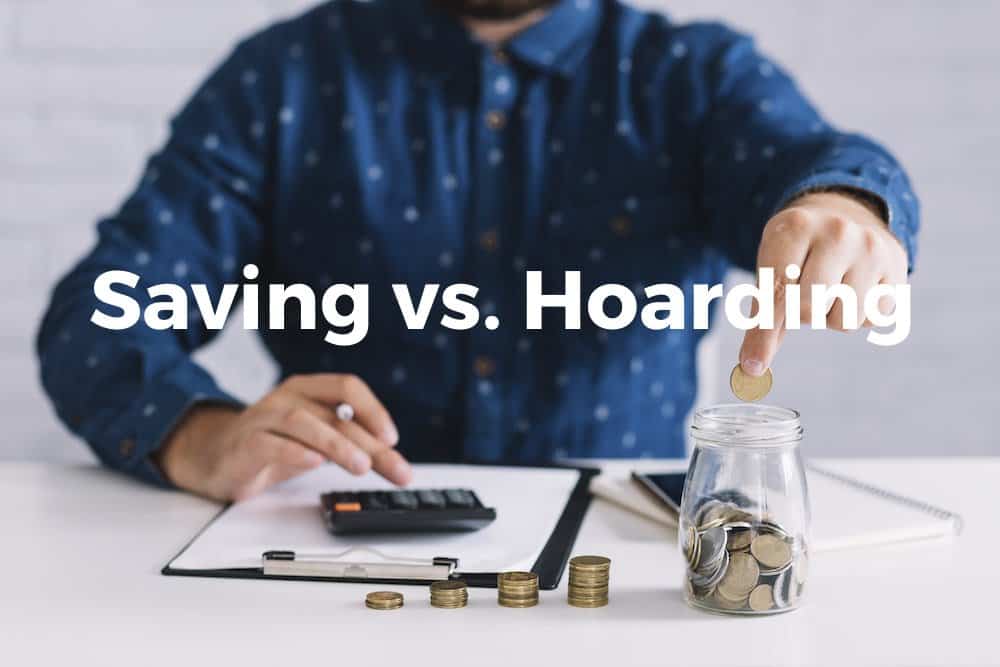When it comes to following a financially sound life, many people have the perspective of saving for a rainy day. Certainly this perspective makes sense but does it ever go too far?
After all, while saving is a financially sound decision, hoarding may be more associated with an emotional approach that can end up being harmful.
The line between the two scenarios may appear fine but there is an important distinction. The intent or reason for accumulating financial reserves can be the most telling factor.
Depending on the reason why money is being saved, the activity either be responsible and productive or detrimental.
Goals of Saving Money

When saving money, there is often a purpose or intent in mind. This could be short or long-term in nature.
For example, you might set up a savings account to pay for an upcoming vacation. Chances are that this account would only be in use for a short period of time, may even just a few months.
Alternatively, the longer-term savings could be used for a house, car, or other substantial purposes. Saving for retirement is considered a goal-oriented strategy that is productive and also responsible.
Signs of Saving Money
If you’re unsure of whether you’re saving or hoarding, there are a few signs that you’re saving money instead of hoarding it.
1. Money is Earmarked for a Purpose
Like mentioned above, money that is being saved has a specific use in mine. This money can be saved for a slightly non-specific purpose such as home emergency repairs, funds to cover a loss of job, or an emergency situation.
Even those these are not known expenses and they may not even occur. However, they are still savings that have a purpose in mind. It’s certainly a responsible step to take since emergencies are not usually anticipated specifically.
Money may also be saved for a specific purpose such as an upcoming purchase or retirement.
2. You Plan to Use the Money
People who save their money also know how it’s going to be used. If you’re saving for retirement, you know that you’re going to use that money as you age.
If you’re saving for a vacation, then you know the money will be used on vacation. Not only that, but you also are going to be willing to use the money when you meet that goal.
For example, if you have the money for a vacation but refuse to take the planned vacation or spend the money, then you’re probably moving into hoarding territory.
3. You Allocate Money Effectively
Saving doesn’t simply mean putting money aside. It also means putting money aside appropriately. You need a certain amount of money for different items in your life.
Most budgets have allocated spending and saving. For example, you may set aside a certain amount of money each month for retirement but you also have plans to spend a certain amount on food, rent, and other expenses.
People who are saving appropriately have their money allocated between spending, saving, and investing. This doesn’t mean that they never run into problems.
After all, everyone makes mistakes. However, they know how to create balance with their income for the most part.
Goals of Being a Hoarder

When it comes to hoarding money, it’s actually characterized by not having a goal. The purpose of a hoarder is to accumulate financial resources but there is not a goal for the funds that are set aside.
There is also not a plan in place for how to use the money at some point in time. People who engage in hoarding will even avoid purchasing the required items in order to add more to their accounts.
Signs of Hoarding Money
If you’re not sure of how hoarding money works, there are a few signature signs that you can watch for. Many people aren’t even aware that they hoard money but it can be helpful to review the common signs.
1. You Save Out of Habit, Not Purpose
If you don’t have any specific goals in mind when it comes to saving, then this may be a sign that you’re saving just to fulfill a habit.
Your savings aren’t going to mean much if they trade off what you need right now for a non-specific purpose. Many times people save from anxiety or emotion rather than a short or long-term goal.
2. You Continue Saving Despite Having Enough
It’s the age-old tale of a person dying in poverty and then coming to realize that this person had more than enough funds to live comfortably.
Unfortunately, this is not as uncommon as it sounds. We all make budgets to predict future expenses and allocate money towards them while attempting to save.
It’s a wise decision to have a percentage of your income as a savings target but excessively adding to this fund is redundant and may actually be over-accumulated. Instead, you may have been better off investing this money or diverting it towards better use.
3. Although You Can Afford Things, You Can’t Spend
Money needs to be able to be used in order for it actually to have value. This means that you should use money as you have it allocated.
You may not be a spendthrift and it’s certainly a good idea to be thrifty. However, if you find that it’s almost impossible for you to spend then you may be falling into the habit of hoarding.
Hoarders resist spending money and may even do without necessities. You certainly don’t have to be a spendthrift but if you don’t buy new clothes or shop for groceries although you can afford them, you’re probably venturing into hoarding territory.
Spending and Hoarding Money
If you want to know what is the difference between saving and hoarding money, this breakdown gives you a good comparison to review.
Being responsible with your finances means not only knowing when to save but also how to spend. By being smart with your finances and avoiding falling into hoarding habits, you can be in good financial health for life.

